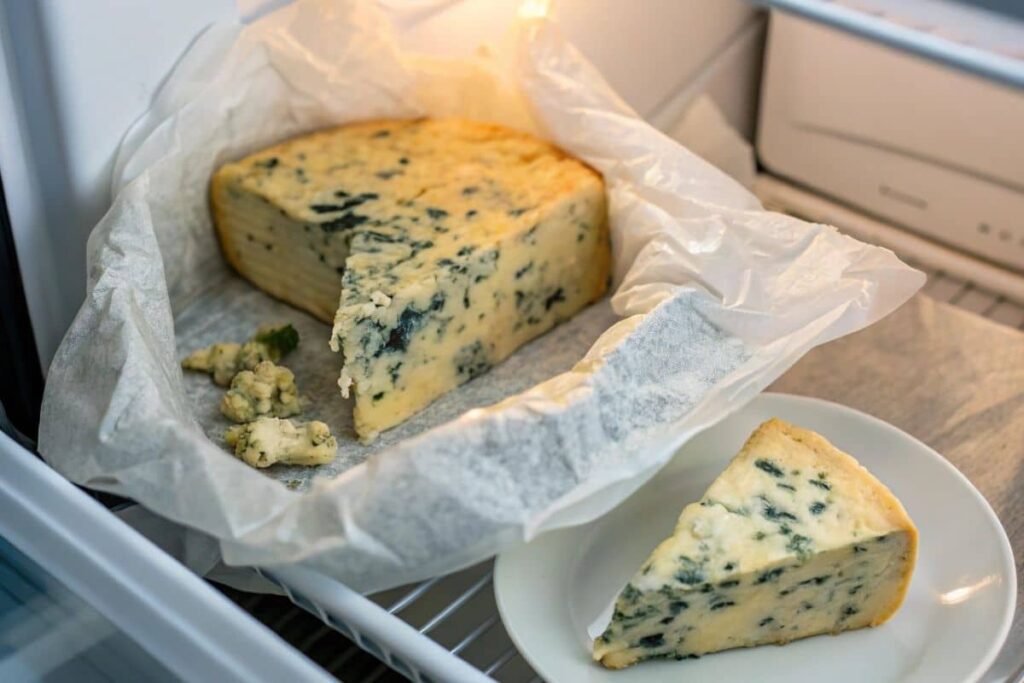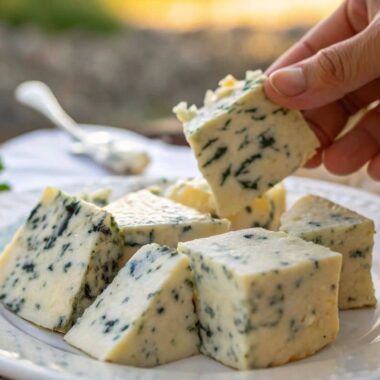How long does blue cheese last in the fridge? It’s a common question for cheese lovers and those trying to avoid food waste. Blue cheese is a polarizing food—some adore its bold, tangy flavor, while others consider it an acquired taste. If you’re among the fans, chances are you’ve got some sitting in your fridge. So, how long can you keep it before it’s no longer safe or tasty to eat? Let’s break it down and explore the key facts about storing blue cheese
Table of Contents

Understanding Blue Cheese
What Is Blue Cheese?
Blue cheese is a type of cheese made with cultures of the mold Penicillium. Sounds strange, right? But this mold is what gives blue cheese its characteristic blue (or green) veins and its sharp, tangy flavor. Don’t worry, it’s perfectly safe to eat and has been enjoyed for centuries.
This cheese comes in a variety of textures and strengths, ranging from creamy and mild to crumbly and pungent. But here’s the magic: those funky flavors work wonders in everything from salads to sauces.
“Blue cheese isn’t just a food; it’s an adventure for your taste buds!”
Why Is Blue Cheese Unique?
What makes blue cheese stand out is its aging process. After the cheese is made, it’s pierced with needles to let air in. This encourages the mold to grow, creating those beautiful marbled streaks. The mold also contributes to its distinctive aroma and taste.
If you’re thinking, “Mold in my food? Seriously?”—remember that blue cheese mold is edible and adds flavor, not harm.
Popular Varieties of Blue Cheese
There are so many types of blue cheese, and each has its own unique twist. Here are some fan favorites:
| Type | Origin | Texture | Flavor Profile |
|---|---|---|---|
| Roquefort | France | Creamy | Sharp and salty |
| Gorgonzola | Italy | Soft to crumbly | Mild to tangy |
| Stilton | England | Crumbly | Rich and nutty |
| Danish Blue | Denmark | Semi-soft | Mild and creamy |
Optimal Storage Conditions
Storing this type of cheese isn’t rocket science, but it does require a little care. Ideally, keep it in the fridge at a temperature between 34°F and 38°F (that’s 1°C to 3°C). The colder, the better—just don’t freeze it unless absolutely necessary.
Why is this so important? It’s a living product with active cultures that need proper conditions to thrive. Too warm, and they go wild (not in a good way). Too cold, and they lose their magic.
How to Wrap for Freshness
Plastic wrap? Nope. This cheese needs to breathe, so it’s best to use parchment paper or wax paper first. Then, place it in an airtight container or a resealable bag to keep it from drying out. This setup allows enough air circulation while preventing excess moisture and odors from seeping in.
Does Packaging Type Affect Shelf Life?
Absolutely. Ever notice how pre-packaged versions from the store last longer than the chunk you bought from the deli? That’s because vacuum-sealed packaging locks out air, which slows spoilage. Once opened, though, the clock starts ticking.
To extend freshness, always store properly wrapped leftovers and consume them within the recommended time frame to enjoy full flavor without spoilage.
“Think of your cheese like a fancy guest—it appreciates being pampered and kept comfortable.”
Shelf Life of Blue Cheese
How Long Does Blue Cheese Last Unopened?
Unopened, especially when vacuum-sealed, this cheese can stay fresh for 2-3 months in the fridge. Always check the “best by” date for guidance, but don’t panic if it’s slightly past the date. Unlike milk, it doesn’t spoil instantly. If it looks and smells fine, it’s probably still good.
How Long Does Blue Cheese Last Once Opened?
Once exposed to air, its shelf life shortens. Typically, an opened piece will last about 1-2 weeks in the fridge. The key to maintaining freshness is proper wrapping—using parchment paper first, then placing it in an airtight container to keep excess moisture out.
Can You Store Blue Cheese in the Freezer?
Technically, yes—but it’s not always the best idea. Freezing alters the texture, making it crumbly rather than creamy. However, if you plan to use it in cooked dishes like soups or sauces, freezing works fine. Just wrap it tightly to prevent freezer burn and use it within 2-3 months.
Nutrition Facts of Blue Cheese (Per 1 oz/28g)
| Nutrient | Amount |
|---|---|
| Calories | 100 |
| Fat | 8g |
| Saturated Fat | 5g |
| Protein | 6g |
| Sodium | 400mg |
| Calcium | 15% DV |
Signs Blue Cheese (or Roquefort) Has Gone Bad
Since this type of cheese is a living product, it naturally changes over time. But how do you know if it has crossed the line from aging to spoiling? Here’s a quick guide to help distinguish between normal characteristics and signs of deterioration.
Visual Signs of Spoilage
The blue or green veins are completely normal—that’s what gives it its signature look! However, if you notice fuzzy white, black, or pink mold on the surface, that’s a warning sign. Also, check for excessive discoloration, such as yellow or brown patches, which indicate spoilage.
“Think of your cheese as a treasure map: the blue veins are the X marking deliciousness, but stray colors are warning signs to stop!”
Changes in Texture and Smell
Blue cheese is supposed to be creamy or crumbly, depending on the variety. But if it starts to feel slimy, sticky, or excessively dry, it’s probably past its prime.
As for the smell? Roquefort has a strong aroma, but it should never smell rotten or like ammonia. Trust your nose—if something seems off, it probably is.
Is Mold Growth Safe or Dangerous?
Here’s the tricky part: mold is both a friend and foe to blue cheese. The veins of Penicillium are harmless (and delicious!), but molds that grow outside the intended veins can be dangerous. If you’re unsure, it’s better to toss it than take a risk.
Pro Tip: Always use clean utensils when cutting blue cheese to avoid introducing unwanted bacteria.
Common Problems with Blue Cheese Storage
Even if you’re storing your Roquefort like a pro, some common issues might still pop up. Here’s how to tackle them:
Why Does Blue Cheese Dry Out?
One of the biggest enemies of blue cheese is dryness. Without proper wrapping, it can lose moisture and become tough. The solution? Use parchment or wax paper to maintain its ideal texture.
Preventing Cross-Contamination
Cheese is like a sponge—it absorbs flavors and odors from its surroundings. If you store blue cheese near onions, garlic, or strong-smelling foods, don’t be surprised if it tastes funny. Always keep it in a separate container to protect its unique flavor.
How Temperature Fluctuations Affect Quality
Ever notice how some cheese turns hard or soggy? That’s the result of temperature changes. If you leave your blue cheese out on the counter for hours and then return it to the fridge, its quality will deteriorate faster. Keep it cold and consistent.
“Think of Roquefort as a sensitive artist—too much change, and it loses its charm.”
Tips for Prolonging Blue Cheese Freshness
Want to keep your cheese fresh and fabulous? Follow these tips:
Best Practices for Storage
- Wrap it well: Always use parchment paper or wax paper.
- Airtight is right: Store it in a sealed container or bag.
- Use quickly: Opened cheese is best enjoyed within a week or two.
Using Moisture-Controlled Compartments
Many refrigerators have a crisper drawer or a dairy compartment. These spaces are perfect for blue cheese because they maintain a consistent level of humidity. If your fridge lacks one, consider adding a small damp paper towel to the container.
Creative Uses for Blue Cheese Before It Expires
Got some Roquefort nearing its end? Don’t waste it! Here are a few ideas:
- Make a dressing: Whip up a creamy blue cheese dressing for salads or wings.
- Melt it into pasta: Blue cheese adds a luxurious touch to mac and cheese.
- Create a cheese board: Pair it with fruits like pears and figs for a quick snack.
Fun Fact: Blue cheese pairs wonderfully with honey—try it for a sweet and savory twist!
A Recipe You’ll Love: Creamy Roquefort Pasta

Creamy Roquefort Pasta
Ingredients
- 12 oz 340g pasta (tagliatelle, fettuccine, or penne)
- 5 oz 140g Roquefort cheese, crumbled
- 1 cup 240ml heavy cream
- 2 tbsp butter
- 2 cloves garlic minced
- ¼ cup Parmesan cheese optional, for extra creaminess
- Black pepper to taste
- Salt to taste
- Fresh parsley chopped (for garnish)
- ¼ cup walnuts chopped (optional, for crunch)
Instructions
Instructions
Cook the Pasta
- Bring a large pot of salted water to a boil.
- Cook the pasta until al dente, according to package instructions.
- Drain and set aside, reserving ½ cup of pasta water.
Prepare the Sauce
- Melt butter in a large skillet over medium heat.
- Add minced garlic and sauté for about 1 minute until fragrant.
- Reduce heat to low and pour in heavy cream, stirring gently.
Melt the Roquefort
- Add crumbled Roquefort cheese and stir until it melts into the sauce.
- Stir in Parmesan cheese if using, for extra creaminess.
Combine Pasta and Sauce
- Toss the cooked pasta into the sauce, mixing well to coat every strand.
- If needed, add reserved pasta water a little at a time to loosen the sauce.
- Season with black pepper and adjust salt if needed.
Garnish and Serve
- Sprinkle with fresh parsley and chopped walnuts (if using).
- Serve immediately and enjoy this creamy, flavorful dish!
Notes
- For a richer taste, add a splash of white wine when melting the cheese.
- Love tangy flavors? Sprinkle extra crumbled Roquefort on top before serving.
- Want some protein? Try adding grilled chicken or crispy pancetta for a heartier meal.
Frequently Asked Questions
Whether you’re new to this bold-flavored cheese or a long-time fan, here are answers to some of the most common questions to help you enjoy your Roquefort to the fullest.
Can Blue Cheese Be Left at Room Temperature?
Ideally, blue cheese should always be stored in the fridge. However, if you’re serving it at a gathering or using it in a recipe, it can safely sit at room temperature for 2-4 hours. After that, bacteria can start to develop, and the texture and flavor will deteriorate.
Pro Tip: Serve smaller portions and replenish from the fridge as needed to keep it fresh and safe.
How Do Different Types of Blue Cheese Compare in Longevity?
Not all blue cheeses age the same way. Some are creamier, while others are firmer, affecting their shelf life:
- Gorgonzola – Higher moisture content, spoils faster
- Roquefort – Medium moisture, lasts slightly longer
- Stilton – Firmer texture, longest shelf life
Regardless of type, proper storage is the key to keeping it fresh for as long as possible.
Are Preservatives in Blue Cheese Effective?
While blue cheese doesn’t typically contain artificial preservatives, its natural salts and molds act as a preservative. This gives it a longer shelf life compared to many other cheeses. However, it’s still perishable, so proper handling is crucial to maintain its quality.n last longer than many other cheeses when stored correctly. However, it’s still perishable, so treat it with care.
Conclusion
Blue cheese, or Roquefort as it’s famously known, is a culinary treasure that adds bold flavor and creamy texture to countless dishes. By understanding how to store it properly, identify signs of spoilage, and use it creatively, you can enjoy its unique taste without worry. Whether it’s a rich pasta dish, a fresh salad, or simply paired with fruits and nuts, Roquefort deserves a spot in your fridge.
If you’re curious about other cheese-related topics, check out Is blue cheese good for your gut?, Can I freeze blue cheese?, blue cheese, and Cottage Cheese Recipes for more inspiration. Exploring the world of cheeses opens up endless culinary possibilities, and who doesn’t love that? 🧀
Final Tip: Treat your Roquefort with care, and it will reward you with unforgettable flavor every time!





